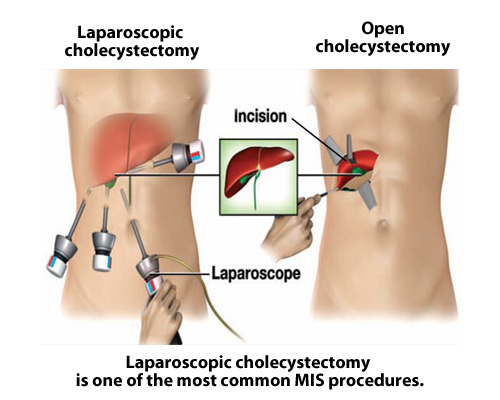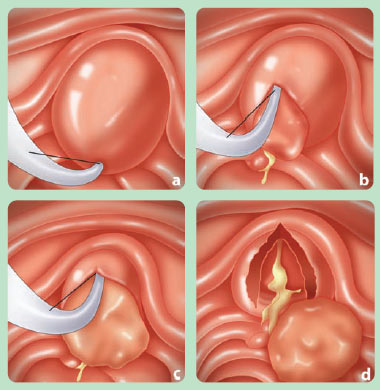What is - Minimally Invasive Surgery (MIS) Procedures in General Surgery
Breast Biopsy and MIS Procedures
Suspicious breast lesions can be biopsied via minimally invasive techniques without the need for open surgery under general anaesthesia. These include ultrasound, mammographic as well as MRI guided core biopsy which can be vacuum assisted (Mammotome). Benign breast lesions may also be removed completely via this method.
Gastrointestinal MIS Procedures
Laparoscopic surgery, the MIS procedure in the abdominal cavity, is the most common form of MIS performed and is used for many gastrointestinal conditions.
It involves making tiny openings of 0.5 to 1 cm in the skin of the abdomen. A laparoscope (tiny telescope) connected to a special fibre-optic camera, which transmits a picture of the abdominal organs on a video monitor, is inserted through a cannula (a small hollow tube) usually at the umbilicus.
Other tubes are inserted through various openings in the abdomen for special instruments to perform the surgery. The surgery is done while viewing the video screen. This allows for the same result as open surgery but with the least possible damage to the body structures.
Laparoscopic Anti-Reflux Procedures
The standard treatment for Gastroesophageal Reflux Disease (GERD) and hiatus hernias (herniation of the stomach into the chest) is laparoscopic fundoplication. In this procedure, the fundus (upper part) of the stomach is wrapped around the lower portion of the oesophagus and stitched in place. This surgery prevents stomach acid from flowing back into the oesophagus, preventing GERD.
With this procedure, about 5 abdominal incisions of 0.5 to 1 cm are used.
Laparoscopic Appendicectomy
This removal of the appendix is performed for acute appendicitis. Laparoscopic appendicectomy is a good alternative for patients with acute appendicitis, especially for young women of childbearing age, as the laparoscopic procedure has a diagnostic advantage for uncertain diagnosis. Other advantages include better cosmetic results, less pain and quicker recovery.
In laparoscopic appendicectomy, 3 tiny openings to insert a miniature camera and surgical instruments are made across the lower part of the tummy to remove the appendix. This compares with a 4 to 6 cm incision needed for an open appendicectomy.

Bariatric (Weight Loss) Surgery
Surgical intervention for obesity, also referred to as bariatric surgery, has consistently been shown to be more effective than medical, dietary and lifestyle treatments alone. Bariatric surgical procedures cause weight loss by modifying parts of the gastrointestinal system. Four types of minimally invasive bariatric procedures are available at SGH:
Gastric Balloon
A silicone balloon is placed in the stomach by endoscopy and filled with a saline solution to give patients a sense of fullness, thereby reducing food intake. Although it is an effective method of weight loss, the balloon must be removed after 6 months because of breakdown by gastric acid.

Laparoscopic Adjustable Gastric Banding (LAGB)
LAGB is used for morbid obesity. An adjustable silicone band is placed around the upper part of the stomach to decrease the size of the stomach so that a person feels full faster, thus eating less and ultimately losing weight. The band is deemed adjustable because a port implanted under the skin allows for fine adjustments.
Laparoscopic Sleeve Gastrectomy (LSG)
In this procedure, the stomach is made into a tube with the excess part up to 85% removed. Although this is a relatively new procedure, early results show that weight loss after LSG is comparable to LAGB.
Laparoscopic Roux-en-Y Gastric Bypass (LRYGB)
This is the most complex bariatric surgical procedure performed at SGH. By reducing the size of the stomach and bypassing part of the small intestine, food intake is not only reduced, the process also limits the body’s ability to absorb calories. This has a great effect on the functioning of the gastrointestinal system and can be remarkably effective in correcting metabolic disorders such as Type II Diabetes Mellitus and hyperlipidaemia.
To achieve the best results, our bariatric surgeons work closely with endocrinologists, dietitians and physiotherapists for a multidisciplinary approach to prepare patients for the best intervention suited to their needs. This support is available at the SGH LIFE Centre.
Laparoscopic Gallbladder Surgery
Laparoscopic cholecystectomy or removal of the gallbladder, is the most common MIS procedure performed daily. The gallbladder is removed to treat gallstone disease which causes symptoms such as pain or complications arising from the gallstones. For bile duct stones or associated abnormalities, exploration of the common bile duct can also be performed laparoscopically together with the cholecystectomy.
With laparoscopic cholecystectomy, several small incisions of 0.5 to 1 cm are made to remove the gallbladder while traditional open cholecystectomy requires a 6 to 14 cm abdominal incision.

Laparoscopic Hernia Repair
Hernias in the groin (inguinal), umbilical and other parts of the body occur when the abdominal wall is weakened and this may result in some abdominal contents such as the intestines bulging out. In laparoscopic surgery, the hernia is repaired from behind the abdominal wall. A small piece of surgical mesh is placed over the hernia defect and held in place with surgical staples.
Laparoscopic Liver Surgery
The laparoscopic segmental hepatectomy (removal of a small part of the liver) may be performed for liver cancers and tumours. For larger tumours or tumours less suitable for a complete laparoscopic technique, the laparoscopic-assisted hepatectomy is performed instead, in which case most of the surgery is performed with the laparoscopic technique. This technique still gives a much smaller incision than the usual open surgery incision.
Other Gastrointestinal MIS Procedures

Thoracic MIS Procedures
- Endoscopic thoracic sympathectomy for hyperhidrosis (sweaty palms).
- Video-assisted thoracic surgery (VATS) for various lung problems including tumours, abscess and bleeding.
Vascular MIS Procedures
Up to 90% of treatments for diseases of the vascular system (arteries or veins) such as aortic aneurysms (a bulge in the aorta), peripheral arterial disease (blockage of arteries) or treatment of varicose vein are now performed by the percutaneous (through the skin), endovascular (through a vein or artery) or laparoscopic (through small incisions) route.
Endovascular Aortic Stent Grafting and Laparoscopic Aortic Surgery
Endovascular Aneurysm Repair (EVAR) involves the insertion of a stent graft into the aorta through the thigh arteries via small incisions in both groins. Custom-made stents (special tubes made to support the blood vessels while keeping them open) are available for grafting of even the most complex aortic aneurysms without the need for open surgery. This is performed jointly with the interventional radiologists.
For patients who are unsuitable for stenting, or unable to afford the cost of a stent, a further option of a laparoscopic approach is available, thereby minimising or avoiding the full abdominal incision required to perform traditional aortic surgery.

Percutaneous Transluminal Arterioplasty (PTA) and Stenting
Percutaneous angiography and angioplasty procedures (including balloon angioplasty) are commonly performed for patients with various arterial narrowing or blockages such as in the carotid, kidney and leg vessels, or in veins. This has decreased the number of open arterial interventions and bypass surgeries in recent years.
Endovenous Laser Treatment for Varicose Veins
A range of minimally invasive options for treatment of varicose veins is possible. These include injection sclerotherapy, foam sclerotherapy and laser treatment.

Upper Gastrointestinal Endoscopic Procedures
This involves inserting an endoscope (a flexible fibre-optic telescope with channels where special instruments can be inserted) for treatment of problems such as bleeding ulcers, varices (abnormally swollen veins in the oesophagus) as well as bile duct stones. This has decreased the need for open surgery for these conditions.

Contributed by
The information provided is not intended as medical advice. Terms of use. Information provided by SingHealth.
Condition Treated At
Department
Surgery
Department
Hepato-Pancreato-Biliary Surgery
Department
General Surgery
Department
Department of Surgery
Get to know our doctors at SingHealth Hospitals in Singapore.
Get to know our doctors at SingHealth Hospitals in Singapore. here.



















